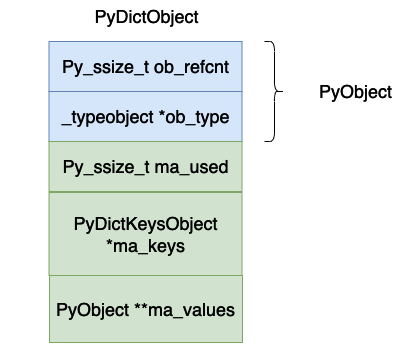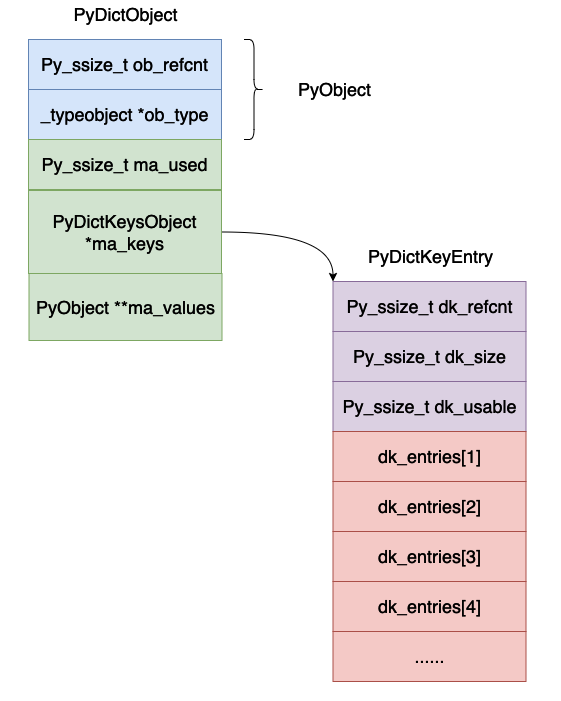 Backend Development
Backend Development
 Python Tutorial
Python Tutorial
 What is the implementation principle of dictionary in Python virtual machine
What is the implementation principle of dictionary in Python virtual machine
What is the implementation principle of dictionary in Python virtual machine
Dictionary data structure analysis
/* The ma_values pointer is NULL for a combined table
* or points to an array of PyObject* for a split table
*/
typedef struct {
PyObject_HEAD
Py_ssize_t ma_used;
PyDictKeysObject *ma_keys;
PyObject **ma_values;
} PyDictObject;
struct _dictkeysobject {
Py_ssize_t dk_refcnt;
Py_ssize_t dk_size;
dict_lookup_func dk_lookup;
Py_ssize_t dk_usable;
PyDictKeyEntry dk_entries[1];
};
typedef struct {
/* Cached hash code of me_key. */
Py_hash_t me_hash;
PyObject *me_key;
PyObject *me_value; /* This field is only meaningful for combined tables */
} PyDictKeyEntry;
The meaning of each field above is:
- ##ob_refcnt, the reference count of the object.
- ob_type, the data type of the object.
- ma_used, the number of data in the current hash table.
- ma_keys, points to the array holding key-value pairs.
- ma_values, this points to an array of values, but this value is not necessarily used in the specific implementation of cpython, because the objects in the PyDictKeyEntry array in _dictkeysobject can also store values. This The value may only be used when all keys are strings. In this article, the value in PyDictKeyEntry is mainly used to discuss the implementation of the dictionary, so you can ignore this variable.
- dk_refcnt, this is also used to represent reference counting. This is related to the dictionary view. The principle is similar to reference counting, so we will ignore it here for now.
- dk_size, this represents the size of the hash table, which must be 2n. In this case, the modular operation can be turned into a bitwise AND operation.
- dk_lookup, this represents the lookup function of the hash table, it is a function pointer.
- dk_usable, indicates how many key-value pairs are available in the current array.
- dk_entries, hash table, where key-value pairs are actually stored.

static PyObject *
dict_new(PyTypeObject *type, PyObject *args, PyObject *kwds)
{
PyObject *self;
PyDictObject *d;
assert(type != NULL && type->tp_alloc != NULL);
// 申请内存空间
self = type->tp_alloc(type, 0);
if (self == NULL)
return NULL;
d = (PyDictObject *)self;
/* The object has been implicitly tracked by tp_alloc */
if (type == &PyDict_Type)
_PyObject_GC_UNTRACK(d);
// 因为还没有增加数据 因此哈希表当中 ma_used = 0
d->ma_used = 0;
// 申请保存键值对的数组 PyDict_MINSIZE_COMBINED 是一个宏定义 值为 8 表示哈希表数组的最小长度
d->ma_keys = new_keys_object(PyDict_MINSIZE_COMBINED);
// 如果申请失败返回 NULL
if (d->ma_keys == NULL) {
Py_DECREF(self);
return NULL;
}
return self;
}
// new_keys_object 函数如下所示
static PyDictKeysObject *new_keys_object(Py_ssize_t size)
{
PyDictKeysObject *dk;
Py_ssize_t i;
PyDictKeyEntry *ep0;
assert(size >= PyDict_MINSIZE_SPLIT);
assert(IS_POWER_OF_2(size));
// 这里是申请内存的位置真正申请内存空间的大小为 PyDictKeysObject 的大小加上 size-1 个PyDictKeyEntry的大小
// 这里你可能会有一位为啥不是 size 个 PyDictKeyEntry 的大小 因为在结构体 PyDictKeysObject 当中已经申请了一个 PyDictKeyEntry 对象了
dk = PyMem_MALLOC(sizeof(PyDictKeysObject) +
sizeof(PyDictKeyEntry) * (size-1));
if (dk == NULL) {
PyErr_NoMemory();
return NULL;
}
// 下面主要是一些初始化的操作 dk_refcnt 设置成 1 因为目前只有一个字典对象使用 这个 PyDictKeysObject 对象
DK_DEBUG_INCREF dk->dk_refcnt = 1;
dk->dk_size = size; // 哈希表的大小
// 下面这行代码主要是表示哈希表当中目前还能存储多少个键值对 在 cpython 的实现当中允许有 2/3 的数组空间去存储数据 超过这个数则需要进行扩容
dk->dk_usable = USABLE_FRACTION(size); // #define USABLE_FRACTION(n) ((((n) << 1)+1)/3)
ep0 = &dk->dk_entries[0];
/* Hash value of slot 0 is used by popitem, so it must be initialized */
ep0->me_hash = 0;
// 将所有的键值对初始化成 NULL
for (i = 0; i < size; i++) {
ep0[i].me_key = NULL;
ep0[i].me_value = NULL;
}
dk->dk_lookup = lookdict_unicode_nodummy;
return dk;
}#define GROWTH_RATE(d) (((d)->ma_used*2)+((d)->ma_keys->dk_size>>1))
- Calculate the size of the new array.
- Create a new array.
- Add the data from the original hash table to the new array (that is, the re-hashing process).
static int
insertion_resize(PyDictObject *mp)
{
return dictresize(mp, GROWTH_RATE(mp));
}
static int
dictresize(PyDictObject *mp, Py_ssize_t minused)
{
Py_ssize_t newsize;
PyDictKeysObject *oldkeys;
PyObject **oldvalues;
Py_ssize_t i, oldsize;
// 下面的代码的主要作用就是计算得到能够大于等于 minused 最小的 2 的整数次幂
/* Find the smallest table size > minused. */
for (newsize = PyDict_MINSIZE_COMBINED;
newsize <= minused && newsize > 0;
newsize <<= 1)
;
if (newsize <= 0) {
PyErr_NoMemory();
return -1;
}
oldkeys = mp->ma_keys;
oldvalues = mp->ma_values;
/* Allocate a new table. */
// 创建新的数组
mp->ma_keys = new_keys_object(newsize);
if (mp->ma_keys == NULL) {
mp->ma_keys = oldkeys;
return -1;
}
if (oldkeys->dk_lookup == lookdict)
mp->ma_keys->dk_lookup = lookdict;
oldsize = DK_SIZE(oldkeys);
mp->ma_values = NULL;
/* If empty then nothing to copy so just return */
if (oldsize == 1) {
assert(oldkeys == Py_EMPTY_KEYS);
DK_DECREF(oldkeys);
return 0;
}
/* Main loop below assumes we can transfer refcount to new keys
* and that value is stored in me_value.
* Increment ref-counts and copy values here to compensate
* This (resizing a split table) should be relatively rare */
if (oldvalues != NULL) {
for (i = 0; i < oldsize; i++) {
if (oldvalues[i] != NULL) {
Py_INCREF(oldkeys->dk_entries[i].me_key);
oldkeys->dk_entries[i].me_value = oldvalues[i];
}
}
}
/* Main loop */
// 将原来数组当中的元素加入到新的数组当中
for (i = 0; i < oldsize; i++) {
PyDictKeyEntry *ep = &oldkeys->dk_entries[i];
if (ep->me_value != NULL) {
assert(ep->me_key != dummy);
insertdict_clean(mp, ep->me_key, ep->me_hash, ep->me_value);
}
}
// 更新一下当前哈希表当中能够插入多少数据
mp->ma_keys->dk_usable -= mp->ma_used;
if (oldvalues != NULL) {
/* NULL out me_value slot in oldkeys, in case it was shared */
for (i = 0; i < oldsize; i++)
oldkeys->dk_entries[i].me_value = NULL;
assert(oldvalues != empty_values);
free_values(oldvalues);
DK_DECREF(oldkeys);
}
else {
assert(oldkeys->dk_lookup != lookdict_split);
if (oldkeys->dk_lookup != lookdict_unicode_nodummy) {
PyDictKeyEntry *ep0 = &oldkeys->dk_entries[0];
for (i = 0; i < oldsize; i++) {
if (ep0[i].me_key == dummy)
Py_DECREF(dummy);
}
}
assert(oldkeys->dk_refcnt == 1);
DK_DEBUG_DECREF PyMem_FREE(oldkeys);
}
return 0;
}static void
insertdict_clean(PyDictObject *mp, PyObject *key, Py_hash_t hash,
PyObject *value)
{
size_t i;
size_t perturb;
PyDictKeysObject *k = mp->ma_keys;
// 首先得到 mask 的值
size_t mask = (size_t)DK_SIZE(k)-1;
PyDictKeyEntry *ep0 = &k->dk_entries[0];
PyDictKeyEntry *ep;
i = hash & mask;
ep = &ep0[i];
for (perturb = hash; ep->me_key != NULL; perturb >>= PERTURB_SHIFT) {
// 下面便是遇到哈希冲突时的处理办法
i = (i << 2) + i + perturb + 1;
ep = &ep0[i & mask];
}
assert(ep->me_value == NULL);
ep->me_key = key;
ep->me_hash = hash;
ep->me_value = value;
}The above is the detailed content of What is the implementation principle of dictionary in Python virtual machine. For more information, please follow other related articles on the PHP Chinese website!

Hot AI Tools

Undresser.AI Undress
AI-powered app for creating realistic nude photos

AI Clothes Remover
Online AI tool for removing clothes from photos.

Undress AI Tool
Undress images for free

Clothoff.io
AI clothes remover

Video Face Swap
Swap faces in any video effortlessly with our completely free AI face swap tool!

Hot Article

Hot Tools

Notepad++7.3.1
Easy-to-use and free code editor

SublimeText3 Chinese version
Chinese version, very easy to use

Zend Studio 13.0.1
Powerful PHP integrated development environment

Dreamweaver CS6
Visual web development tools

SublimeText3 Mac version
God-level code editing software (SublimeText3)

Hot Topics
 1663
1663
 14
14
 1419
1419
 52
52
 1313
1313
 25
25
 1263
1263
 29
29
 1236
1236
 24
24
 PHP and Python: Different Paradigms Explained
Apr 18, 2025 am 12:26 AM
PHP and Python: Different Paradigms Explained
Apr 18, 2025 am 12:26 AM
PHP is mainly procedural programming, but also supports object-oriented programming (OOP); Python supports a variety of paradigms, including OOP, functional and procedural programming. PHP is suitable for web development, and Python is suitable for a variety of applications such as data analysis and machine learning.
 Choosing Between PHP and Python: A Guide
Apr 18, 2025 am 12:24 AM
Choosing Between PHP and Python: A Guide
Apr 18, 2025 am 12:24 AM
PHP is suitable for web development and rapid prototyping, and Python is suitable for data science and machine learning. 1.PHP is used for dynamic web development, with simple syntax and suitable for rapid development. 2. Python has concise syntax, is suitable for multiple fields, and has a strong library ecosystem.
 PHP and Python: A Deep Dive into Their History
Apr 18, 2025 am 12:25 AM
PHP and Python: A Deep Dive into Their History
Apr 18, 2025 am 12:25 AM
PHP originated in 1994 and was developed by RasmusLerdorf. It was originally used to track website visitors and gradually evolved into a server-side scripting language and was widely used in web development. Python was developed by Guidovan Rossum in the late 1980s and was first released in 1991. It emphasizes code readability and simplicity, and is suitable for scientific computing, data analysis and other fields.
 Python vs. JavaScript: The Learning Curve and Ease of Use
Apr 16, 2025 am 12:12 AM
Python vs. JavaScript: The Learning Curve and Ease of Use
Apr 16, 2025 am 12:12 AM
Python is more suitable for beginners, with a smooth learning curve and concise syntax; JavaScript is suitable for front-end development, with a steep learning curve and flexible syntax. 1. Python syntax is intuitive and suitable for data science and back-end development. 2. JavaScript is flexible and widely used in front-end and server-side programming.
 How to run sublime code python
Apr 16, 2025 am 08:48 AM
How to run sublime code python
Apr 16, 2025 am 08:48 AM
To run Python code in Sublime Text, you need to install the Python plug-in first, then create a .py file and write the code, and finally press Ctrl B to run the code, and the output will be displayed in the console.
 Where to write code in vscode
Apr 15, 2025 pm 09:54 PM
Where to write code in vscode
Apr 15, 2025 pm 09:54 PM
Writing code in Visual Studio Code (VSCode) is simple and easy to use. Just install VSCode, create a project, select a language, create a file, write code, save and run it. The advantages of VSCode include cross-platform, free and open source, powerful features, rich extensions, and lightweight and fast.
 Can visual studio code be used in python
Apr 15, 2025 pm 08:18 PM
Can visual studio code be used in python
Apr 15, 2025 pm 08:18 PM
VS Code can be used to write Python and provides many features that make it an ideal tool for developing Python applications. It allows users to: install Python extensions to get functions such as code completion, syntax highlighting, and debugging. Use the debugger to track code step by step, find and fix errors. Integrate Git for version control. Use code formatting tools to maintain code consistency. Use the Linting tool to spot potential problems ahead of time.
 Golang vs. Python: Key Differences and Similarities
Apr 17, 2025 am 12:15 AM
Golang vs. Python: Key Differences and Similarities
Apr 17, 2025 am 12:15 AM
Golang and Python each have their own advantages: Golang is suitable for high performance and concurrent programming, while Python is suitable for data science and web development. Golang is known for its concurrency model and efficient performance, while Python is known for its concise syntax and rich library ecosystem.



